I cannot tell you how many times I have read or heard people say ridiculous things when talking about evolution like “So a monkey gave birth to a human” or “We evolved from apes” or “There is no evidence for evolution” or “It can’t prove how life started so it’s worthless” or one of the classic arguments from the ignoramus “Evolution is just a theory so it could be wrong”. Then I have to correct them by explaining that species don’t just give birth to new species because evolution happens slowly and gradually, and that we didn’t evolve from apes rather we shared a common ancestor with the apes, and that the evidence for evolution is overwhelming, and that Charles Darwin’s theory explains the origins of species, not the origin of life, and that evolution is just a theory in the same sense that the germ theory of disease and the theory of gravity are just theories.
Evolution is the cumulative adaptation to environmental pressures. Evolution is cumulative because it builds upon the current features and traits of the organism through successive additions. Adaptations are any traits that contribute to the probability of the organism surviving and multiplying. The environment is where the organism lives, and environmental pressures are any factors that affect an organism’s ability to survive and reproduce.

(Credit Leonard Eisenberg)
A species living on flat plains could be adapted to avoiding predators and catching prey by being spindly and speedy. On wide open, flat land, speed would be a survival advantage. If some members of its species wander onto the nearby mountainside, maybe due to overpopulation on the plains or scarcity of food or introduction of a new predator on the plain environment or because they got lost in a storm – the reason itself doesn’t matter; a new trait other than speed might be selected for, like strength for climbing over hills and rocks. Over many successive generations the stronger and bulkier –but slower – members of the group will have more reproductive success, passing on their traits of strength and bulk to their offspring. The fast spindly members of the group will eventually fade from existence as their traits are not suited to this new mountain environment. Their spindly and speedy cousins on the nearby plain will still be selected for being spindly and speedy. If the two groups stay separated long enough, eventually the stronger and bulkier group will grow further and further apart from their spindly and speedy cousins and the two groups will have evolved into two separate species. But remember, they shared the same distant common ancestors. Something like this probably happened to donkeys and horses in their evolutionary history.
That’s it. That’s what evolution is in a nutshell. A good way to visualize how it works is by imagining a branch on a tree splitting into two different twigs. The tips of the two twigs are the new species, but they connect back to the one branch on the tree. With that, it’s time to take a look at the process by which evolution works.
Further reading: Climbing Mount Improbable by Richard Dawkins; The Blind Watchmaker by Richard Dawkins
This is extremely interesting! Thank you for explaining!
I’ve never really looked into this indepth before but I am definitely learning something new now. Thanks for explaining.
Super interesting! Always love an easy explanation to something. Thanks for sharing!
Interesting visualization! Thanks for sharing
This is a wonderful way to explain evolution. I like the tree analysis, as that’s something almost anyone can understand. My young boys don’t fully understand the concept, but I could probably explain it better now with this in mind. I feel like it’s connected to “survival of the fittest” although the “fittest” is different depending on the situation.
Just because our make-up is similar to apes, doesn’t mean we evolved from there! Great explanation of evolution!
This is very interesting commentary. It is definitely something one can ponder.
It is so important to review serious topics such as these with a scientific mind. First assumptions need to be checked against the facts, as with evolution – to see that it is more complicated than when people mention the monkey thing.
Thanks for taking your time to explain this. That was a great explanation.
Definitely a concise explanation of what evolution is. Although I have heard of evolutionary theory where its rapid evolutionary changes versus the more slow and progressive evolution. But that’s just different branches of the same theory based on adaptation still.
So much information I ahve learned today about evolution. Quite interesting. Thank you for sharing.
My biggest pet peeve is when people say we couldn’t have evolved from monkeys because there are still monkeys today.
I grew up being told evolution was wrong. So it’s been fun unlearning that bad information. Youtube has definitely been my biggest resource for that. I enjoyed your break down.
I am not really into science because it isn’t something that I am interested in. But, this was really in-depth and a great argument for evolution.
This is such a simple and beautiful explanation for the evolution theory. I never thought about it like this. Thanks for explaining. 😊
Very interesting post. I have never thought deeply about the concept of evolution before so this is super interesting.
Great explanation and information right here. Thank you for a detailed information given.
It has been a long time since I had science in school This was a great reminder, plus a bonus of learning something new, that will help when I am explaining evolution to my sons. Thanks!
Learnt something today, thanks for sharing!
I’m using this the next time I’m trying to have a conversation with people who disagree with fact. Science is a beautiful thing.
Very interesting and informative. Looking forward to more posts.
This is such an interesting post! I guess I had never thought this way about evolution.